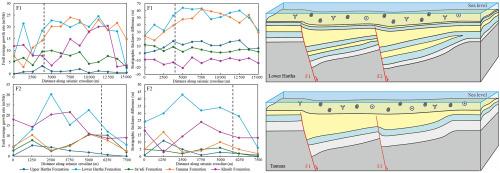Regional sedimentary responses to syndepositional faulting and reservoir potential of Upper Cretaceous limestones in the B Oilfield, Mesopotamian Basin
IF 3.6
引用次数: 0
Abstract
Upper Cretaceous limestones represent the primary reservoirs in the B Oilfield, central Mesopotamian Basin. While syndepositional faults have clear influences on the thickness of these strata, their controls on sedimentation across different reservoir intervals remain poorly understood. This study examines the sedimentary responses to syndepositional faulting during the Late Cretaceous through integrating analysis of fault growth rates and facies distribution across fault blocks. Estimated growth rates for two major faults (F1 and F2) range from 0 to 30 m/Ma, with thickness differences of up to 60 m observed between hanging wall and footwall sites. Fault activity varied over time and was more intense during the deposition of the Lower Hartha and Tanuma formations. This enhanced activity resulted in significant thickness variations and promoted the accumulation of foraminifera and bioclastic packstone facies (MF3/MF2) inside tilted fault-blocks, which are associated with favorable reservoir properties. By influencing facies distribution, syndepositional faulting might also contribute to the development of thicker reservoirs within fault zones. In contrast, fault activity diminished during the deposition of the Upper Hartha and Khasib formations, where more uniform stratigraphic thickness and facies distributions are observed. These findings highlight the critical role of syndepositional faulting in creating accommodation space and enhancing reservoir development conditions in the study area, offering valuable implications for petroleum exploration and reservoir modeling in structurally analogous settings.

美索不达米亚盆地B油田上白垩统同沉积断裂的区域沉积响应及储层潜力
上白垩统灰岩是美索不达米亚盆地中部B油田的主要储层。同沉积断层对这些地层的厚度有明显的影响,但它们对不同储层段沉积的控制作用尚不清楚。本研究通过断层生长速率和断块间相分布的综合分析,探讨了晚白垩世同沉积断裂的沉积响应。两个主要断层(F1和F2)的估计增长率在0 - 30 m/Ma之间,在上盘和下盘之间的厚度差异高达60 m。断层活动随时间而变化,在Hartha和Tanuma组沉积期间更为强烈。这种活动的增强导致了显著的厚度变化,并促进了倾斜断块内有孔虫和生物碎屑包岩相(MF3/MF2)的聚集,这与有利的储层性质有关。同沉积断裂作用通过影响相分布,也可能促进断裂带内较厚储层的发育。而上哈尔塔组和哈西卜组沉积时期,断层活动减弱,地层厚度和相分布更为均匀。这些发现突出了同沉积断裂在研究区创造可容纳空间和改善储层发育条件方面的关键作用,为构造类似环境下的石油勘探和储层建模提供了有价值的指导。
本文章由计算机程序翻译,如有差异,请以英文原文为准。
求助全文
约1分钟内获得全文
求助全文

 求助内容:
求助内容: 应助结果提醒方式:
应助结果提醒方式:


